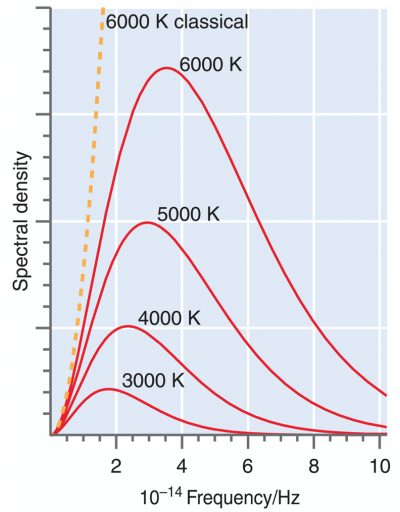Difference between revisions of "PChem322 s21 w1"
Jump to navigation
Jump to search
| Line 36: | Line 36: | ||
:::* Manipulate[Plot[{a*x^2, a*x^3}, {x, 0, 10}, PlotRange -> {0, 2000}], {a, 1, 2}] | :::* Manipulate[Plot[{a*x^2, a*x^3}, {x, 0, 10}, PlotRange -> {0, 2000}], {a, 1, 2}] | ||
| − | :Challenge: Reproduce the Figure 1.2 above for Plank's Blackbody Radiation | + | :'''Challenge''': Reproduce the Figure 1.2 above for Plank's Blackbody Radiation |
==Friday, Jan 29, 2021== | ==Friday, Jan 29, 2021== | ||
====Sec 1.4 The Photoelectric Effect==== | ====Sec 1.4 The Photoelectric Effect==== | ||
Revision as of 19:26, 28 January 2021
Monday Jan 25, 2021
- - Welcome
- - Attendance
- - Syllabus/Expectations
Weds, Jan 27, 2021
Chapter 1: From Classical to Quantum Mechanics
Intro, Sec 1.1, Sec 1.2
Read
Sec 1.3 Blackbody Radiation
- - All objects are essentially "hot" (considering the concept of absolute zero).
- - All (hot) objects radiate light (electromagnetic radiation).
- - The wavelength/frequency of the light emitted from a (hot) object is related to the temperature of the object.
- - We can make a graph of wavelength (λ) or frequency (ν) as a function of temp (T), but at any given temperature light emitted has a range of λ or ν. So instead we develop some expressions using the term spectral density (ρ - rho).
Thurs, Jan 28, 2021
Meet in CSB 378
Activities
- Mathematica Activity
- - Basic Plot statement
- Plot[x^2, {x, 0, 10}]
- - Plotting 2 function on one graph
- Plot[{x^2, X^3}, {x, 0, 10}]
- - "Manipulate" a Plot
- Manipulate[Plot[{a*x^2, a*x^3}, {x, 0, 10}], {a, 1, 2}] ...with y-axis range defined
- Manipulate[Plot[{a*x^2, a*x^3}, {x, 0, 10}, PlotRange -> {0, 2000}], {a, 1, 2}]
- - Basic Plot statement
- Challenge: Reproduce the Figure 1.2 above for Plank's Blackbody Radiation
